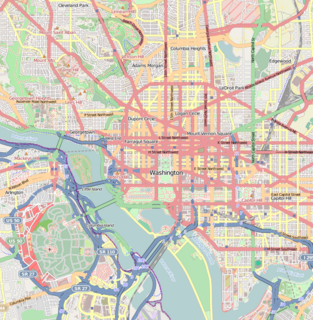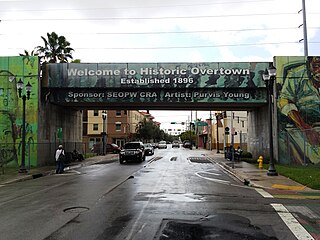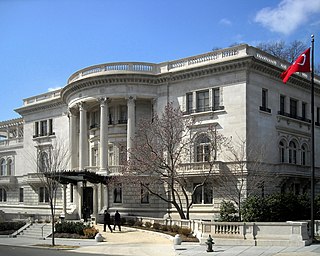Related Research Articles

Pennsylvania Avenue is a diagonal street in Washington, D.C., and Prince George's County, Maryland, that connects the White House and the United States Capitol and then crosses the city to Maryland. In Maryland it is also Maryland Route 4 to MD 717 in Upper Marlboro, where it becomes Stephanie Roper Highway. The section between the White House and Congress is called "America's Main Street"; it is the location of official parades and processions, as well as protest marches. Moreover, Pennsylvania Avenue is an important commuter road and is part of the National Highway System.

Artondale is a census-designated place (CDP) in Pierce County, Washington, United States. The population was 12,653 at the 2010 census.

Embassy Row is the informal name for the section of Massachusetts Avenue, N.W. between Scott Circle and the North side of the United States Naval Observatory in Washington, D.C., in which embassies, diplomatic missions, and other diplomatic representations in the United States are concentrated. By extension, the name may be used to encompass nearby streets which also host diplomatic buildings.

Swampoodle was a neighborhood in Washington, D.C. on the border of Northwest and Northeast in the second half of 19th and early 20th century. This neighborhood is no longer known as Swampoodle and has been replaced in large part by NoMa.
Boundary Field, also known as American League Park II and National Park, is a former baseball ground in Washington, D.C. located on the site currently occupied by Howard University Hospital; bounded approximately by Georgia Avenue, 5th Street, W Street and Florida Avenue, NW. It was just outside what was then the city limit of Washington, whose northern boundary was Boundary Street which was renamed Florida Avenue in 1890.

There are many outdoor sculptures in Washington, D.C. In addition to the capital's most famous monuments and memorials, many figures recognized as national heroes have been posthumously awarded with his or her own statue in a park or public square. Some figures appear on several statues: Abraham Lincoln, for example, has at least three likenesses, including those at the Lincoln Memorial, in Lincoln Park, and the old Superior Court of the District of Columbia. A number of international figures, such as Mohandas Gandhi, have also been immortalized with statues. The Statue of Freedom is a 19½-foot tall allegorical statue that rests atop the United States Capitol dome.

Mount Vernon Square is a city square and neighborhood in the Northwest quadrant of Washington, D.C. The square is located where the following streets would otherwise intersect: Massachusetts Avenue NW, New York Avenue NW, K Street NW, and 8th Street NW.
St. John's College High School in Washington, D.C., established in 1851, is the second oldest Christian Brothers School in the United States, and the oldest Army JROTC school. It was founded by Brother John of Mary, F.S.C., and two other Christian Brothers in St. Matthew's parish, at 15th and G Streets.

Wisconsin Avenue is a major thoroughfare in Washington, D.C., and its Maryland suburbs. The southern terminus begins in Georgetown just north of the Potomac River, at an intersection with K Street under the elevated Whitehurst Freeway. The section of Wisconsin Avenue in Georgetown was called High Street before the street names in Georgetown were changed in 1895 to conform to those of the L'Enfant Plan for the federal city.

Petworth is a residential neighborhood in the Northwest quadrant of Washington, D.C. It is bounded to the east by the Armed Forces Retirement Home and Rock Creek Cemetery, to the west by Arkansas Avenue NW, to the south by Rock Creek Church Road NW and Spring Road NW, and to the north by Kennedy Street NW.

Overtown is a neighborhood of Miami, Florida, United States, just northwest of Downtown Miami. Originally called Colored Town during the Jim Crow era of the late 19th through the mid-20th century, the area was once the preeminent and is the historic center for commerce in the black community in Miami and South Florida.
The streets and highways of Washington, D.C., form the core of the city's surface transportation infrastructure. Given that it is a planned city, streets in the capital of the United States follow a distinctive layout and addressing scheme. There are 1,500 miles (2,400 km) of public roads in the city, of which 1,392 miles (2,240 km) are owned and maintained by the district government.

New Hampshire Avenue is a diagonal street in Washington, D.C., beginning at the Kennedy Center and extending northeast for about 5 miles (8 km) and then continuing into Maryland where it is designated Maryland Route 650. New Hampshire Avenue, however, is not contiguous. It stops at 15th and W Streets NW and resumes again on the other side of Columbia Heights at Park Road NW, a few blocks from Georgia Avenue. New Hampshire Avenue passes through several Washington neighborhoods including Foggy Bottom, Dupont Circle, Petworth and Lamond-Riggs.

The Northwest District is a densely populated retail and residential neighborhood in the northwest section of Portland, Oregon. Craftsman-style and Old Portland-style houses are packed tightly together with grand old apartment buildings and sleek new condominiums, within walking distance of restaurants, bars, and shops. The Portland Streetcar's first line terminates there, connecting the district to the Pearl District, Downtown Portland and points south to the South Waterfront, and several TriMet bus lines also serve the district.

Garfinckel's was a prominent department store chain based in Washington, D.C. that catered to a clientele of wealthy consumers. Its flagship store at 14th and F in the city's F Street shopping district is listed on the National Register. It filed for Chapter 11 bankruptcy in June 1990 and ceased operations that year.
Julius Garfinckel was a prominent American merchant, business executive and philanthropist. He was the founder of the Washington, D.C., department store Garfinckel's.
Raleigh Haberdasher, more commonly called Raleigh's, was a high end, local men's and women's furnishings store based in Washington, D.C.
The Frank R. Jelleff Co., or more commonly Jelleff's was a Washington, D.C.-based retailer that specialized in women's apparel.
Bond Clothing Stores, Bond Clothes, Bond Clothiers, or Bond Stores, was a men's clothing manufacturing company and retailer. The company catered to the middle-class consumer.

George Oakley Totten Jr., was one of Washington D.C.’s most prolific and skilled architects in the Gilded Age. His international training and interest in architectural decoration led to a career of continuous experimentation and stylistic eclecticism which is clearly evident in many of his works. The mansions he designed were located primarily on or near Dupont, Sheridan, and Kalorama circles and along 16th Street, N.W., near Meridian Hill. Most now serve as embassies, chanceries, or offices for national or international organizations, their important public or semi-public functions, combined with their urbanistically integrated close-in locations, make them particularly visible exemplars of Washington's peculiar mixture of turn-of-the-century political and social life.
References
- ↑ Finding Aid to Stein-Bloch & Co. records in the Rare Books and Special Collections department, River Campus Libraries, University of Rochester (accessed Sep 16, 2008)
- ↑ Display Advertisements, The Washington Post, 1919-1962.